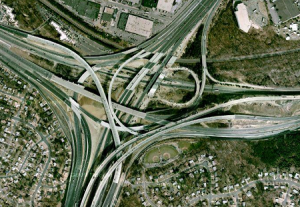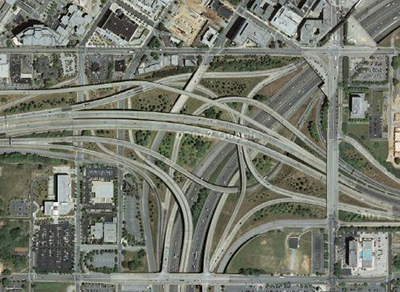Well, it has been a while since I have done a “fun with highways” post here at CatSynth, so why not visit some of the highways I traveled while in China?
Shanghai has a series of highways, most of which are designated with the letter “A” followed by a number:

[photo by ramonyu]
During my trip, I became quite acquainted with the A11 (Huning Expressway) that connects Shanghai to Suzhou and beyond. However, one cannot really view either city from the A11. Nor can one really see the details of the delta region. It’s just a big highway traversing sprawling suburban development like one can see in many parts of the U.S.
By contrast, the A9 extends into the center of Shanghai as the Yan’an Elevated Road. Shanghai makes a distinction between “expressways” and “elevated roads”, though I don’t really see much difference.

The elevated roads are multi-lane freeways, and the Yan’an cuts right through the downtown of the city, closely paralleling the pedestrian thoroughfare Nanjing Road and People’s Square, before ending at The Bund along the river.

[photo by ramonyu]
Essentially, it parallels a major part of my walking tour only a few blocks away.
Photographer Liao Yusheng has a fantastic series of architectural and landscape photos along the Yun’an Elevated Road, along with this description:

Yan’an is part of a sprawling elevated highway system in the heart of Shanghai that epitomizes the gung-ho mega public-works projects that are going on all over China at the moment. This is a six-lane highway that is literally jammed into the middle of a densely packed modern city. Hundreds of thousands of families were displaced and hundreds of millions of dollars were spent to make this happen. In forcing this monstrosity onto an already fully-developed (yet still evolving) megalopolis, Shanghai has created a conduit with which to examine the multilayered texture that makes up this city.
I only discovered his work in preparing this article, but it was a great find and reminds me of my own urban and architectural photography. I encourage readers to check it out!
The story does remind me of the highway development in New York City in the 1950s and 1960s, where entire neighborhoods were demolished to build, among others, the Cross Bronx and Bruckner Expressways. Somehow, we often end up back there.
I did also find that China has it’s own highway enthusiasts, including the blogger Wang Jian Shuo.
















 This is a major interchange in Sacramento, California, where I spent most of yesterday. Running north-south along the river is I-5, while east-west is the Capitol City Freeway (Business 80 and US 50).
This is a major interchange in Sacramento, California, where I spent most of yesterday. Running north-south along the river is I-5, while east-west is the Capitol City Freeway (Business 80 and US 50).







 The
The 
 Returning to San Francisco from New York often involves a highway trip to JFK Airport, and there is one spot along the Van Wyck Expressway (I-678) that is almost always guaranteed to come to standstill, the Kew Gardens Interchange:
Returning to San Francisco from New York often involves a highway trip to JFK Airport, and there is one spot along the Van Wyck Expressway (I-678) that is almost always guaranteed to come to standstill, the Kew Gardens Interchange:










 The
The 

